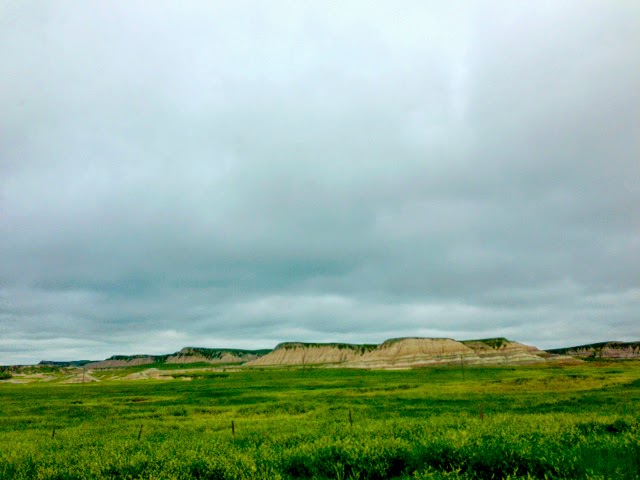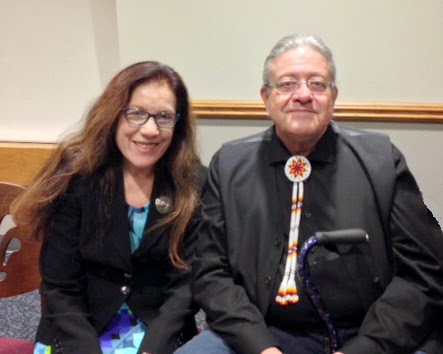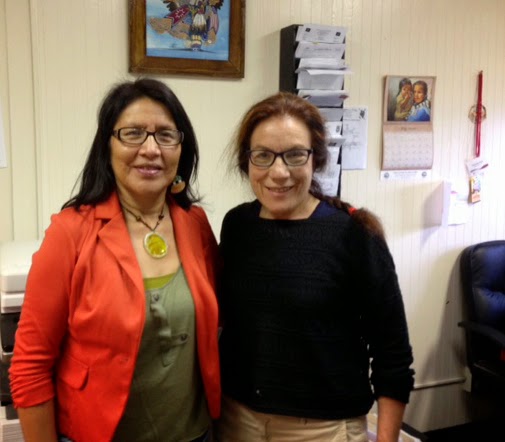Reporting from The Oglala Lakota Reservation in Pine Ridge---
This week's "Lakota Country Times" newspaper, has a column entitled "Rez Ramblings," by Oglala Lakota writer, Leon Matthews. In it, he describes some of the "Mission groups" and tourists that come to the Lakota reservation during the summer. He writes:
"We have the summer short term mission groups coming and repainting houses and playing with our children . . . I think there are some pros and cons when it comes to the groups that roll around in the big buses and white vans . . . a safari type mentality . . . come to check out the poverty. . . Most of the groups are here to try to help our people, but the (Mission/Tour Companies) control what they do and see on the Reservations" (June 5, 2014).
 |
| This poster hangs the Oglala Lakota Council Office wall |
Matthews' comments are exactly why I hesitated to go to Pine Ridge. I did not want to go there to change or interrupt/disrupt anyone there.
I especially did not want to be a part of any "safari mentality." Years ago, I was invited to Africa, and too many times during that trip, I felt much like the kind of "wasicu" Leon Matthews describes above. "Wasicu," is a Lakota word with many meanings two of which are "one who is not native" and "one who takes" ("Wasicu": pronounced wa-shee-koo).
 |
| "Badlands" --not far from a Dialysis Center and Wounded Knee |
I think of Leonard Peltier's Prison Writings where he talks of "junk cars in some Indian family's front yard" and the outsiders (tourists/mission people) who interpret this as just another sign of poverty by saying, "These dirty Indians, how can they live like that..."

Peltier brilliantly continues in this very short section: "Maybe these people, so quick to judge, don't understand the higher mathematics of being poor. They don't realize that, when you can't afford to buy or commercially repair a car, it may take six or eight junkers out in the yard to keep one junker going on the road. Those yard junkers take on a special value in Indian eyes: they're the source of that hard-to-come-by and almost sacred commodity in Indian country--transportation. Without wheels out in the empty distances of the rez, you're utterly isolated. When the family's one working car breaks down, one of those yard junkers may provide precisely the part that's needed so that Pop can drive seventy miles to town each day to his menial job and help feed his often-hungry family. To such a family, those junkers out in the yard represent survival.
Besides, there's often some old auntie who sleeps, even lives, in those old wrecks. And, if you open the trunk or the glove compartment, you'll often see lovingly stacked rows of Indian corn and beans, sage, and sweetgrass, arranged in there like fine jewels. There's poetry in those junkyards. Those old junkers can hold holy things in their rusted innards. Sort of like us Indians. Remember that next time you drive through a rez and see those junkers in the yard. They're holy, too." (Leonard Peltier, Prison Writings: My Life is My Sun Dance pg. 69-70)
So why am I here? I was invited. But even with the invitation, I hesitated. I wanted to make sure the reason to come here was an ethical one. As you know, Queridos "La Bloga" readers, I've been writing and researching on Diabetes. Our Latino people are impacted by Diabetes as much as indigenous populations on both sides of the border. I am here, then, to witness, understand, and learn, how Lakota people are managing the disease.
 |
| Amelia M.L. Montes with President Bryan Brewer |
 |
| Amelia M.L. Montes with Toni Red Cloud, Assistant to President Bryan Brewer |
 |
| Youth development project: Skateboard Park (to keep the youth active) |
 |
| Writing in President Brewer's office. |
 |
| Reservation country. |







3 comments:
Amelia, thank you for this very enlightening post! The pictures are beautiful. I especially appreciated the note on the cars in the yard. I look forward to your next update!
Blessings,
K Lynn Dreher
I love how the author navigates her discomfort and ours, with "safari mentality." Beautifully done.
A beautiful Ledger art hide in the office! I wonder if it's old?
It great that the Lakota own so many horses, maybe they won't need bikes to remain active.
Thanks for your post, we are waiting more!
Post a Comment